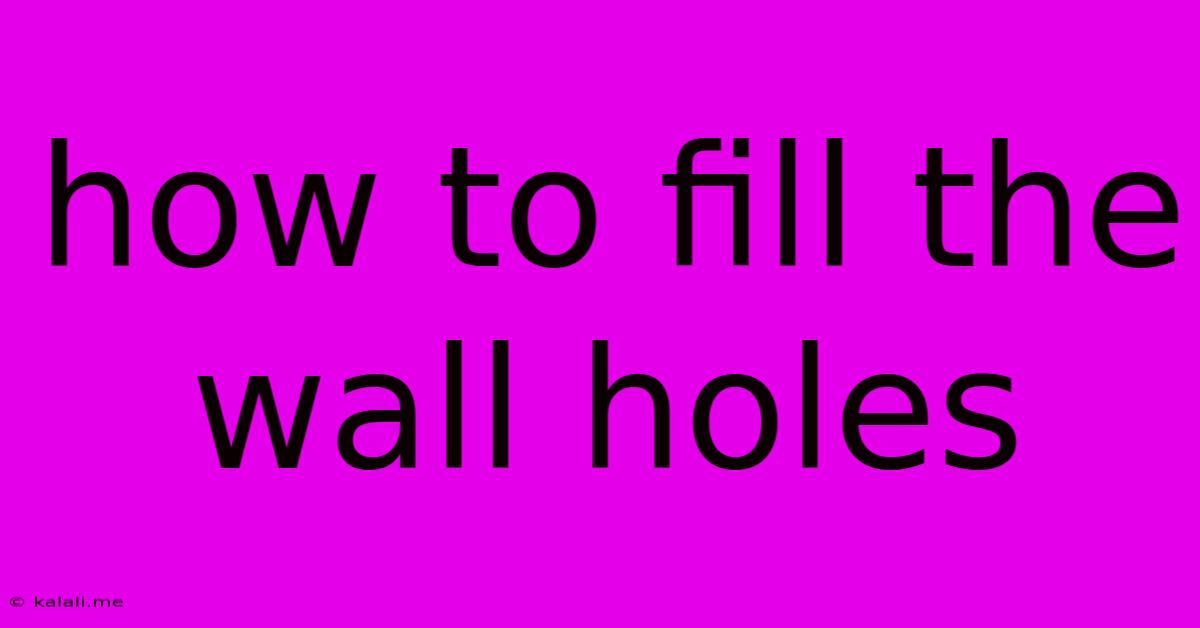How To Fill The Wall Holes
Kalali
May 25, 2025 · 3 min read

Table of Contents
How to Fill Wall Holes: A Comprehensive Guide
Are you staring at unsightly holes in your walls, remnants of misplaced picture hooks or ambitious DIY projects? Don't despair! Fixing those blemishes is easier than you think. This comprehensive guide will walk you through different methods for filling wall holes, from tiny nail holes to larger gaps, ensuring a seamless and professional finish. This process will involve selecting the right filler, prepping the surface, applying the filler, and finishing for a flawless wall repair.
Assessing the Damage: Choosing the Right Filler
The first step in successfully filling wall holes is identifying the size and type of damage. This will dictate the best type of filler to use. Here's a quick breakdown:
-
Small holes (nail holes, pinholes): For these minor imperfections, a lightweight spackle or patching compound is ideal. It's easy to apply and dries quickly.
-
Medium holes (from screws, anchors): A slightly heavier-duty spackle or joint compound might be necessary for these. Joint compound offers a bit more strength and durability.
-
Large holes (significant damage): For larger gaps, you'll likely need a more substantial filler, perhaps a patching plaster or even drywall compound. This provides a strong base for repairing considerable wall damage.
Preparing the Surface: The Key to a Smooth Finish
Before applying any filler, proper surface preparation is crucial for a professional-looking repair. Follow these steps:
-
Clean the hole: Remove any loose debris, dust, or paint chips from the hole using a brush, vacuum cleaner, or a damp cloth. A clean surface ensures better adhesion of the filler.
-
Dampen the area (if necessary): For larger holes or drywall repairs, lightly dampen the surrounding area with a sponge to help the filler adhere better and prevent cracking.
-
Remove loose materials: For larger holes, ensure all loose drywall or plaster is removed before starting the repair process.
Applying the Filler: Techniques for Different Hole Sizes
The application method depends on the size and depth of the hole and the type of filler you're using.
-
Small Holes (Spackle): Use a putty knife to apply a small amount of spackle, pressing it firmly into the hole. Remove excess spackle with a clean, flat putty knife, smoothing the surface.
-
Medium Holes (Joint Compound): For slightly larger holes, you can apply the joint compound using a putty knife or a wider taping knife. Apply in thin layers, allowing each layer to dry completely before applying the next. This prevents cracking and ensures even filling.
-
Large Holes (Patching Plaster/Drywall Compound): For extensive damage, you may need to use patching plaster or drywall compound. This often requires multiple layers, allowing each to dry before applying the next. For significant holes, consider using a drywall patch for added support before filling with compound.
Finishing Touches: Achieving a Perfect Repair
Once the filler is completely dry (check the product instructions for drying time), lightly sand the repaired area with fine-grit sandpaper (120-220 grit) until smooth and even with the surrounding wall. Remove all sanding dust with a brush or cloth. Finally, prime and paint the area to match the existing wall colour, seamlessly blending the repair.
By following these steps, you can successfully fill wall holes, transforming unsightly blemishes into a flawless wall surface. Remember, patience and attention to detail are key to achieving a professional-looking finish. Whether it's a small nail hole or a larger gap, this guide equips you with the knowledge to tackle any wall repair project with confidence.
Latest Posts
Latest Posts
-
How To Remove A Sheared Screw
May 25, 2025
-
How Much Does A Cubic Foot Of Water Weigh
May 25, 2025
-
Realm Of The Mad God Gods
May 25, 2025
-
What Other Npc Like Dearo Give You Xp
May 25, 2025
-
What Does Watch Your Six Mean
May 25, 2025
Related Post
Thank you for visiting our website which covers about How To Fill The Wall Holes . We hope the information provided has been useful to you. Feel free to contact us if you have any questions or need further assistance. See you next time and don't miss to bookmark.